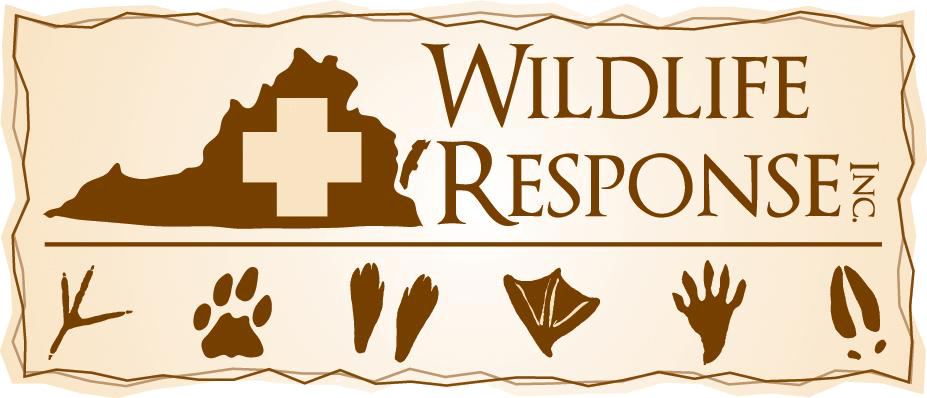
Rescue and Transportation
Babies
If the animal is healthy, and renesting is an option; refer to the section on “Renesting and Reuniting” Procedures. If it is in a position where it cannot be safely renested or reunited with its parent, it will need to come into care. Please remember that baby animals and birds are fragile and usually do not bite. However, you should always use caution. Use gloves and/or a small towel and gently pick up the baby. They can be placed in a small box lined with a towel or soft paper towels or tissue. Cover the box so the baby doesn’t escape, and give no food or water before transporting to the rehabilitator.
Adults
In order to minimize contact between you and a potentially dangerous adult animal, wear thick gloves and use a heavier towel to cover it and place it in a dog or cat crate. In the case of most birds, cardboard boxes may be used safely. Use good judgment and exercise extreme caution as the animal or bird does not realize they are trying to help. Remember, any injured adult could potentially be caring for young, especially if it is a female. Stay alert for possible babies in the area. Do not to give food or water. The confined animal can now be transported to a licensed rehabilitator.
Warming Guidelines
A quick message about warming animals and birds for transportation. Many birds and mammals are found stunned, hit by vehicles, etc. These animals will most likely be losing body heat due to shock. During the spring and summer, young animals are prone to hypothermia because they are no longer in their nest or with siblings to share body heat. There are several methods for warming animals:
a heating pad set on low can be placed below half of the container holding the animal
plastic soda bottles or doubled zip lock baggies filled with warm water can be wrapped in cloth or placed inside socks and placed near the animal
an old sock filled with about one cup of raw, uncooked rice and heated in the microwave for 45-60 seconds will maintain heat for a hour or two
Please be careful not to overheat the animal. Wrap the source of heat in layers of cloth or towel until the temperature feels safe enough to place beside the animal. If they have a small bird or baby mammal, turn it every 15 minutes so his body warms evenly while they transport it to a WRI licensed rehabilitator. Also note: Raptors do not require heat unless they are hypothermic! Raptors will quickly overheat due to stress, and some birds such as Coopers Hawks and Sharp Shinned Hawks may become hyperthermic (overheated) and die on the short drive to the rehabilitator.
Why we ask you to transport
- It can take many hours to find a transporter and the animal you have found needs helps ASAP
- If you do not have a vehicle, please ask a neighbor, friend, or family member to help
- If you are at work, can you transport the animal during lunch or after work, or find a coworker who may be willing to help?
- If absolutely cannot transport the animal you MUST at least contain the animal under a basket, in a yard, etc.
Why you MUST NOT GIVE FOOD OR WATER
- Aspiration of food or fluid can cause pneumonia
- Dehydrated animals will die if given food before being rehydrated
- Birds must be identified to determine proper diet
- The wrong diet or baby formula can be very harmful
Why can’t you raise or keep wildlife
- Young animals and birds require a large amount of care. Birds may need feedings every 10- 15 minutes, and mammals may need 2 – 4 hours feedings around the clock.
- Wild animals do not make good pets. At maturity, most will become aggressive
- Proper nutrition is essential for the animal’s survival
- Wildlife can carry illnesses that can be transferred to humans and pets
- It is illegal in the state of Virginia to hold wildlife without proper permits
Initial Screening
Whether you’ve found a baby bird, turtle in the road, or loon washed up on the beach, please read through the following information to see whether the animal actually needs assistance.
Please contain the animal, because wild animals will try to hide within a short time period of time. If it’s a baby follow our warming guidelines. Also know that since we are a volunteer organization, we rely on the kindness of people like you who have cared enough to help the animal to go that extra step and transport it to one of our licensed wildlife rehabilitators as e do not have regular rescuers and transporters.
If the wildlife you have found is apparently injured, sick, hit by a vehicle, or found near a dog or cat please call our Hotline (757-543-7000) immediately.
If it’s not obviously injured, look for any of the following. If you can answer yes to one or more of the following, please call our Hotline immediately:
- Is there bleeding? (past or present)
- Torn or punctured skin?
- If it’s a bird, does it look extra “inflated“?
- Is there heavy breathing, gasping, lack of regular breathing
- Bruising apparent? Please note: birds bruise green, and do not get gangrene
- Unable to stand, stands awkwardly, drags foot or leg, has a head tilt
- Broken limbs, wing or leg hanging awkwardly or at odd angle
- Is it cold? The bird or animal should be warm to the touch
- Is it thin? Baby birds are mostly abdomen and normally have a pot-bellied appearance, baby mammals should look plump
- If it’s a bird, does the skin on the neck or abdomen look wrinkled or like tissue paper?
- If it’s a mammal, does the skin stay “tented” when pulled up between the shoulder blades?
- Are the eyes clear and bright? Dull or sunken eyes are signs of illness, dehydration, and/or emaciation
- Is it stunned by striking against a window or building, but has no signs of injuries?
- Was the animal found in a chimney, swimming pool, or garage?
- Is it lethargic, sleepy, non-responsive?
- Are there flies or ants on or near the animal/bird?
- Any white or pale yellow “grains of rice” on skin, feathers, feather shafts, fur, or in ears?
- Are dead siblings or parents nearby?
- Have children or pets handled it?
- Is it in immediate danger, does it stay in place when approached?
- Are the weather conditions bad?
- Have you already attempted to reunite or renest?
- Are you just not sure?
Ruby-Throated Hummingbird
(Archilochus colubris)
 Ruby-throated Hummingbirds (RTHUs) are the most widely distributed of the world's 338 species of hummingbirds, all of which occur ONLY in the Western Hemisphere.
Ruby-throated Hummingbirds (RTHUs) are the most widely distributed of the world's 338 species of hummingbirds, all of which occur ONLY in the Western Hemisphere.
Ruby-throated Hummingbirds are Neotropical migrant insect- and nectar-eaters that breed from Florida to Maine; westward across the Great Plains to foothills of the Rockies; from south Texas north to southern Canada; and northwest into Alberta.
Little is known about autumn migrational routes. Some migrant RTHUs apparently fly from Florida to the Yucatan; however, many RTHUs gather in Louisiana or Texas in mid-September before flying across the Gulf, and some may take an overland route through Mexico. Even less is known about spring migrational paths.
There's good evidence that hummers do not fly very high during migration. Over land it is unlikely they get much above treetop height--the better for them to see potential food sources along the migratory route. Hot air balloonists have reported RTHUs at altitudes of up to 500 feet or so. It is certain that hummingbirds would never be able to survive cold temperatures at high altitudes used by waterfowl and larger songbirds, which helps refute the ludicrous myth that hummers hitchhike on the backs of Canada Geese. Over water, hummingbirds have been reported to migrate just above the wave tops; one observer even claimed some hummers get within the curl of a wave, thus allowing the wave itself to serve as a windbreak.
 The Ruby-throated Hummingbird is often found in the ecotone--or edge--between woodland and meadow. In this habitat the bird is close to mature trees in which it typically nests, as well as near a profusion of flowering plants that supply nectar and support small insects--both of which make up its diet. It is a bird that has adapted well in many places to human development, but only if there are shelter, space, and food. Thus, it is frequently seen in suburban backyards with some mature trees and shrubs, in wooded parks, and around farmsteads and orchards. Although the RTHU may be found more frequently near hardwood forests, it also occurs in pine stands in parts of its breeding range. In Canada, its overall distribution stops at the southern edge of the dense boreal forest.
The Ruby-throated Hummingbird is often found in the ecotone--or edge--between woodland and meadow. In this habitat the bird is close to mature trees in which it typically nests, as well as near a profusion of flowering plants that supply nectar and support small insects--both of which make up its diet. It is a bird that has adapted well in many places to human development, but only if there are shelter, space, and food. Thus, it is frequently seen in suburban backyards with some mature trees and shrubs, in wooded parks, and around farmsteads and orchards. Although the RTHU may be found more frequently near hardwood forests, it also occurs in pine stands in parts of its breeding range. In Canada, its overall distribution stops at the southern edge of the dense boreal forest.
Observations in Mexico and Central America indicate that Ruby-throated Hummingbirds select similar habitats to those they use on the breeding and nesting grounds: the edges of thickets and second-growth forests where the woods interface with clearings such as pastures. As in North America, these locations are likely to have viable populations of flowering plants. It should be noted that SOME vegetation disturbance may benefit RTHUs because it results in more "edges," but clear-cutting eliminates all plants they need for nesting, roosting, and/or feeding.
White-Tail Deer
(Odocoileus virginianus)
 White-tailed deer have played a very important role in the history of our country. A major part of Meriwether Lewi’s job was to observe and descried the flora and fauna of the Northwest. He had no reason to write about the common or fallow deer of the East Coast, except for eusing it for comparison purposes, he gave it a very good picture overall. The term “white-tail” occurred in the expedition’s journals only once, when Clark, on June 5, 1805, reported that he “Saw great numbers of Elk & white tail deer.” He was merely using it as a descriptor, not as a name. It didn’t come into popular usage until sometime in the 1860s.
White-tailed deer have played a very important role in the history of our country. A major part of Meriwether Lewi’s job was to observe and descried the flora and fauna of the Northwest. He had no reason to write about the common or fallow deer of the East Coast, except for eusing it for comparison purposes, he gave it a very good picture overall. The term “white-tail” occurred in the expedition’s journals only once, when Clark, on June 5, 1805, reported that he “Saw great numbers of Elk & white tail deer.” He was merely using it as a descriptor, not as a name. It didn’t come into popular usage until sometime in the 1860s.
They were used extensively by Native Americans for both food and clothing and also by the early settlers.
White-tailed deer are the smallest of the three members of the deer family found in North America, the others being elk and moose.
The white-tailed deer is the oldest species of deer in the world today, its first appearance dating back to the Pliocene, perhaps 3.5 million years ago. There are now 38 subspecies of the white tail occupying a range that extends from the jungles of northern South America to the fringes of Canada’s boreal forests, and from the Atlantic Coast to the Pacific Northwest.
 “White-tailed” refers to the distinctive white tail that when raised provides a flash of white signaling other deer when danger is near. They are graceful and swift runners that can reach up to 35 mph. Male deer are called “bucks”, females “does”, and baby deer “fawn”. They live in female-led family groups of up to 25 deer and can live as long as 10 years or more. Buck deer are primarily solitary animals except during the breeding season (also called the “rut”).
“White-tailed” refers to the distinctive white tail that when raised provides a flash of white signaling other deer when danger is near. They are graceful and swift runners that can reach up to 35 mph. Male deer are called “bucks”, females “does”, and baby deer “fawn”. They live in female-led family groups of up to 25 deer and can live as long as 10 years or more. Buck deer are primarily solitary animals except during the breeding season (also called the “rut”).
They have two seasonal coats. In the spring/summer their coat is reddish tan, relatively short, with thin and wiry hair. The winter coat is grayish or bluish tan with heavy, long hairs with a thick coat. White patches are found around the eyes, throat belly, inside of legs and underside of the tail. The fawns have white spots in a reddish-brown background enabling them to blend in with their surroundings. In the later part of the summer the fawn starts to loose it’s spots and they get a grayish coat. They are active around the clock, but less so during the daylight hours. They are usually on the move during the dawn and dusk. Deer have been recorded leaping heights of as much as eight (8) feet to clear a fence or barrier. We have identified at least 13 different sounds that they make for various activities and behaviors. Antlers play an important role in deer society. Rubbing the antlers on trees marks territories and sparring matches.
 White-tailed deer prefer an area with diverse food and cover types. The perfect habitat would include a mixture of forest, brushland, cropland and fields. They eat a variety of items; some of the items are: wild crabapple, corn, sumac, Japanese honeysuckle, grasses, greenbriar, clover soybeans, jewelweed, acorns, and not limited to dogwoods.
White-tailed deer prefer an area with diverse food and cover types. The perfect habitat would include a mixture of forest, brushland, cropland and fields. They eat a variety of items; some of the items are: wild crabapple, corn, sumac, Japanese honeysuckle, grasses, greenbriar, clover soybeans, jewelweed, acorns, and not limited to dogwoods.
 When born male fawns weigh about 4-14 pounds and femails 3-8 pounds. They are born with their eyes open and can walk within 1-2 hours. Fawns nurse 2-3 times a day. They come out of hiding to nurse then go back into hiding. At about one month the fawn begins to accompany their mother. They will stay together until the following spring. Female fawns will remain in proximity to their mother their whole life. The bucks are forced to leave in the fall, if they haven’t already.
When born male fawns weigh about 4-14 pounds and femails 3-8 pounds. They are born with their eyes open and can walk within 1-2 hours. Fawns nurse 2-3 times a day. They come out of hiding to nurse then go back into hiding. At about one month the fawn begins to accompany their mother. They will stay together until the following spring. Female fawns will remain in proximity to their mother their whole life. The bucks are forced to leave in the fall, if they haven’t already.
Great Horned Owl
(Bubo virginianus)
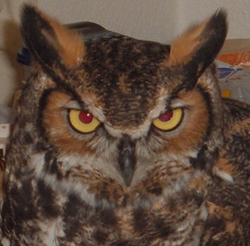 The Great Horned Owl is one of the larger owls in North America. The Great Horned Owl average size is 22 inches long with a wingspan of about 3 feet. The “horns” are only tufts of feathers. They are brown with some spotted coloration in darker shades of brown.
The Great Horned Owl is one of the larger owls in North America. The Great Horned Owl average size is 22 inches long with a wingspan of about 3 feet. The “horns” are only tufts of feathers. They are brown with some spotted coloration in darker shades of brown.
The Great Horned Owl mates in Late January or early February laying 2-3 eggs once a year. The eggs are incubated by both parents and hatch in about four weeks. The owls mature quickly.
This owl is found across North America in valleys, grasslands, woodlands, forests and city parks. Here in the Hampton Roads area it is found everywhere.
They eat mainly squirrels, rabbits, small mammals and other birds but are not limited to that diet. They swallow their food whole and later regurgitate what their body cannot process in owl pellets. They have excellent hearing and fly silently through the air that aids in hunting nocturnally. They will swoop down to catch their prey with powerful feet and talons.
Territories. The territory for a mated pairs may range 1/3 of a mile to 2-5 square miles. Some ornithologists (scientists who study birds) believe that owls form permanent pair-bonds. If one; after the courtship displays end, the male continues to hoot to maintain territory and the female remains near the selected nest until time to lay the eggs. She lays them in the debris (wood chips or other plant matter) in the bottom of the nest. The number of eggs laid seems to be linked to available food supplies. Normally the female lays 2-3 dull white, thick-shelled, oval-shaped eggs. Owls lay only one clutch of eggs per season. Some females nest only every other year. Females in prime habitat may nest every year.
Incubation of the eggs lasts through the winter. Both the females and the eggs can survive extremely cold weather. Incubation usually takes 26-35 days with both sexes sharing in the process. The male feeds the female during this time.
Once the owlets hatch, the male brings large quantities of food to the nest. Prey is stored in the nest, since young owlets will eat their nest mates if not kept constantly fed.
Newly hatched owls are covered with white natal (birth) down. Their eyes open at 9 days and function poorly for the first 2 weeks after opening. The owlet cannot hold up its head. After 3 weeks buff-colored, mottled looking down replaces the natal down. The owlets need constant brooding (female sits on nest and covers owlets) to protect them from cold and predators. A female owl will viciously attack both animal and human invaders during this time.
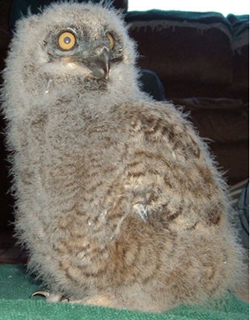 Owlets begin growing their primary feathers (main, adult feathers) at 3 weeks of age. They have light yellow eyes with blue pupils. Less brooding is necessary and they are very active about the nest. Owlets learn to eject excrement (body waste) over the side of the nest but sometimes fall due to their clumsiness. About this time the owlets begin using a defensive display when disturbed. They raise their feathers, fan their wings downward, and hiss or snap their bill.
Owlets begin growing their primary feathers (main, adult feathers) at 3 weeks of age. They have light yellow eyes with blue pupils. Less brooding is necessary and they are very active about the nest. Owlets learn to eject excrement (body waste) over the side of the nest but sometimes fall due to their clumsiness. About this time the owlets begin using a defensive display when disturbed. They raise their feathers, fan their wings downward, and hiss or snap their bill.
After 5-6 weeks, the female coaxes the owlets out of the nest by offering food from a nearby branch. At about 9-10 weeks old the owlets first flight out of the nest to the ground. They quickly scramble up a tree to get away from ground level predators. If approached by a predator, they assume a hiding pose by sitting still and erect against the side of the tree. If this pose fails they present the defensive display.
Feedings become irregular but the young owlets remain with the female and beg for food until September or October. During mid-June, the young owlets use their inborn instinct to attack prey. Young owls leave their parent's home range in autumn, when they are fully independent and can find their own hunting territory.
When a member of the pair dies, the survivor remains in the home territory until another mate arrives.
Owls defend their territories from other owls. Defense occurs during breeding times. It lasts from 1 month before breeding until the young owlets leave the parental territory. Adults may wander across territory lines for a short time before the next breeding season begins. They frequently allow other types of birds such as hawks to live in their territory.
Owls with large territories frequently spend each season in a different part of their territory. Owls use specific areas of their territory for nesting and roosting. Some birds use certain trees so regularly that observers can predict in which trees they will find the owl in during a specific season.
During the winter and fall, owls prefer evergreen roost trees since they provide daytime cover. When these are not available, owls will adapt to any place that provides as much concealment as possible during daylight hours. They seem to prefer to roost in isolated trees in small forest openings.
Eastern Snapping Turtle
(Chelydra serpentina serpentina)
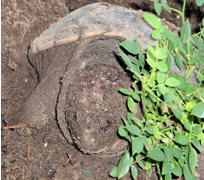 The Eastern Snapping Turtle has a flattened carapace (upper shell) with knobby keels that smooth out with age. They can reach up to 19 inches in length and weighing from 10-35 pounds. It has a large head, small plastron (lower shell), and a long saw-toothed tail on the upper side. The carapace is brown and the plastron is cream to light brown with various degrees of black in it. The skin on the head, neck and limbs is dark brown to black. The large head has a blunt protruding snout. The carapace is often covered with algae. Breeding season is from April to November. Incubation is from 80-90 days and laying of the eggs usually happens in June. The eggs are hard shelled, white and spherical (like ping-pong balls) in shape. They lay their eggs in a flask shaped hole that the females dig in a variety of soils.
The Eastern Snapping Turtle has a flattened carapace (upper shell) with knobby keels that smooth out with age. They can reach up to 19 inches in length and weighing from 10-35 pounds. It has a large head, small plastron (lower shell), and a long saw-toothed tail on the upper side. The carapace is brown and the plastron is cream to light brown with various degrees of black in it. The skin on the head, neck and limbs is dark brown to black. The large head has a blunt protruding snout. The carapace is often covered with algae. Breeding season is from April to November. Incubation is from 80-90 days and laying of the eggs usually happens in June. The eggs are hard shelled, white and spherical (like ping-pong balls) in shape. They lay their eggs in a flask shaped hole that the females dig in a variety of soils.
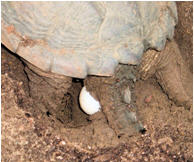 The snapping turtle is found throughout the state of Virginia including on some of the barrier islands. They have a large range of habitat. They are found in rivers, swamps, ponds, lakes, streams, freshwater, and brackish marshes. They are usually active from March through October but can be found any time of the year.
The snapping turtle is found throughout the state of Virginia including on some of the barrier islands. They have a large range of habitat. They are found in rivers, swamps, ponds, lakes, streams, freshwater, and brackish marshes. They are usually active from March through October but can be found any time of the year.
They prefer dead but not rotting fish but they will also eat, crayfish, toads, frogs, terrestrial insects, muskrats, aquatic plants and algae. The adult snappers have one primary predator; MAN!!!
CFC Campaign
The Combined Federal Campaign (CFC) allows and facilitates regular donations to charities for federal employees. "The mission of the CFC is to promote and support philanthropy through a program that is employee focused, cost-efficient, and effective in providing all federal employees the opportunity to improve the quality of life for all."
WRI is an authorized charity and the campaign is handled by the CFC of South Hampton Roads . Typically the CFC for each year has deadline of Feb. 1st. Please be sure contact the CFC of South Hampton Roads for more information and for pledge forms.
Our charity number for the CFC is 23037.
More information about the CFC can be found at www.opm.gov/cfc .
Thank you for your help.
